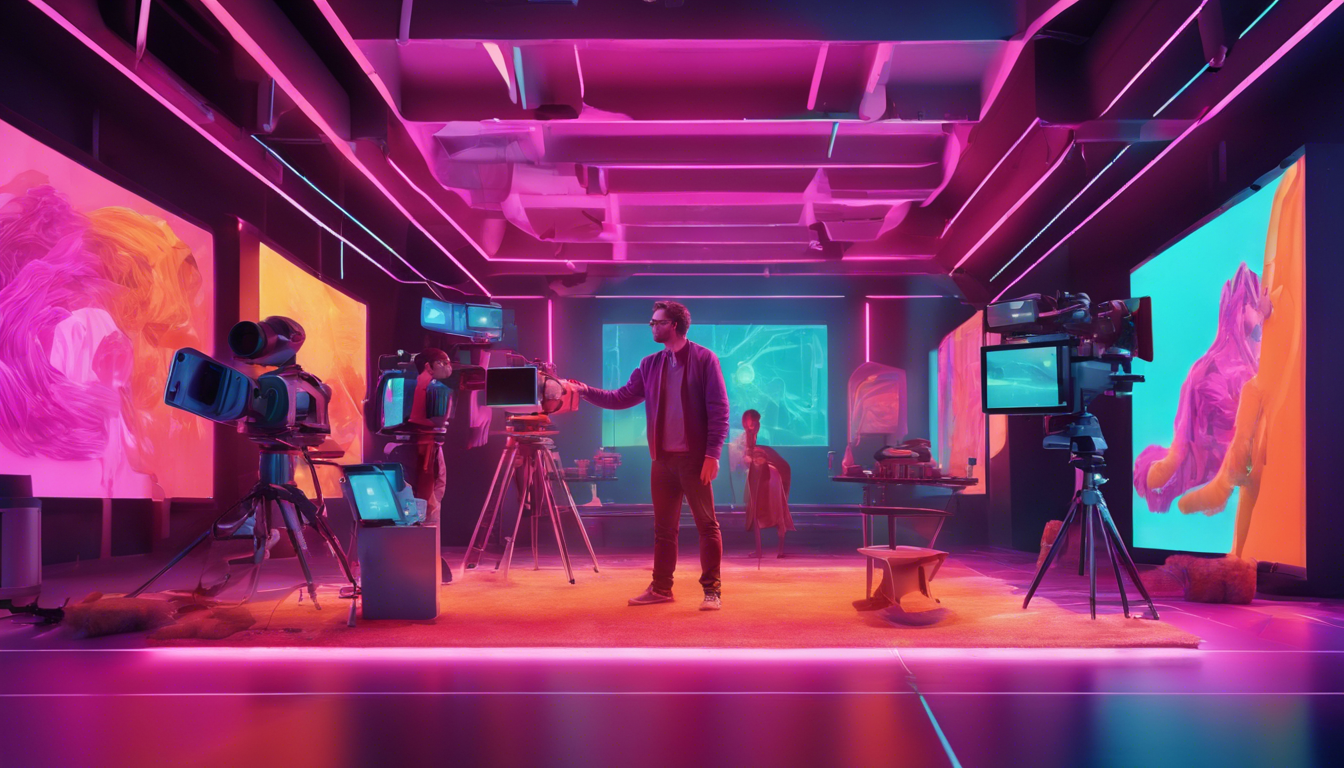
Lights, camera, and action!
Welcome to the dazzling new frontier of filmmaking where the magic of augmented reality in post-production is flipping the script on how we tell stories—literally!
In a world where the ordinary meets extraordinary, augmented reality (AR) isn’t just for tech geeks with VR headsets; it’s a bona fide game changer for screenwriters and filmmakers alike.
Imagine crafting visuals that leap off the screen, immersing audiences in worlds so vibrant they can practically touch them.
Wowza!
In this quirky journey, we’ll unpack the pizzazz of augmented reality in post-production, dissect its benefits, explore funky techniques, and highlight some jaw-dropping case studies.
Buckle up, dear creators, because the future of visual storytelling is about to get a whole lot more exciting!
The BEST AI Screenwriting Tool On The Market!
Key Takeaways
- Augmented reality enhances the narrative depth of visual media in post-production.
- Integrating AR provides unique engagement opportunities for audiences.
- Advanced AR tools demand new skills and techniques from post-production professionals.
- Successful case studies showcase AR’s potential in transforming traditional storytelling methods.
- Challenges such as technical limitations and cost still need to be addressed for widespread AR adoption.
Understanding Augmented Reality in Post-Production
Ah, augmented reality in post-production!
It’s like adding a sprinkle of fairy dust to your cinematic masterpiece and watching it transform from a humble potato into a stunning French fries platter—who knew you could take something so plain and make it practically delicious?!
So, what’s the scoop on this curious little trend that’s sweeping the film world?
For screenwriters and filmmakers, understanding augmented reality post-production is crucial, as it breathes life into your visual narratives like a shot of espresso for groggy morning production meetings.
This innovative technology doesn’t just enhance visuals; it creates a whole new reality that can hook audiences faster than a cat meme on social media.
Imagine blending live-action sequences with fantastical elements that dance right off the screen—all enabled by augmented reality.
Gone are the days when you had to rely solely on CGI (sorry, CGI, we still love you).
With augmented reality post-production, you’re not just creating a film; you’re crafting an experience that viewers will relish, tweet about, and reference in their crossover fan fiction!
So as you dive into crafting your next screenplay, keep this magical tool in your back pocket—it may just become your secret weapon for captivating storytelling.
The Benefits of Integrating Augmented Reality
Let’s face it, the world of filmmaking is a bit like a buffet – there are so many delicious options to choose from, and if you don’t try a little bit of everything, you might just miss out on the pièce de résistance!
Enter augmented reality post-production, the kaleidoscopic topping that can elevate your cinematic dish from a mere snack to a five-star feast!
Imagine enhancing your storytelling by layering digital elements right into your existing footage – yes, that’s the magic of AR!
It allows you to transport audiences to new dimensions without breaking the bank or losing your sanity.
With augmented reality post-production, you can create immersive worlds, highlight critical plot twists with a sprinkle of visuals, and woo your audience with an interactive experience that will have them buzzing long after the credits roll.
So, if you’re a screenwriter or filmmaker looking to spice up your narrative and keep your viewers on the edge of their seats, integrating AR just might be the secret ingredient you’ve been looking for!
‘The best way to predict the future is to invent it.’ – Alan Kay
Techniques and Tools for AR Post-Production
Welcome to the whimsical world of augmented reality post-production, where your wildest cinematic dreams can leap off the screen and into the unsuspecting hearts of your viewers!
If you’re a screenwriter or filmmaker looking to sprinkle some pixelated magic into your project, you’re in luck.
Let’s embark on this quirky adventure through techniques and tools that will transform your basic footage into a dazzling AR spectacle.
First up, software like Adobe Aero and Unity is your best friend in this realm.
They allow you to seamlessly integrate 3D models and animations into real-world environments.
Imagine your actors engaging with imaginary creatures while your audience wonders if they’re part of some sci-fi fever dream.
Next, consider utilizing compositing techniques that blend live-action with CGI like a fine wine and cheese pairing; they each enhance the other’s flavor.
And remember, color grading in tools like DaVinci Resolve can elevate your world, giving it the magical hues that scream, “This is a universe unlike any other!” So, strap on those creative goggles and get ready to dive into augmented reality post-production—where the only limit is your imagination, and maybe your computer’s processing power!
The BEST AI Screenwriting Tool On The Market!
Case Studies: Successful AR Applications in Film and Media
Ladies and gentlemen, gather ’round as we embark on a dazzling journey through the shimmering world of augmented reality post-production!
You might be thinking, ‘What in the name of Spielberg is augmented reality doing in the realms of film and media?’ Well, hold onto your director’s chairs because we’re diving into some jaw-dropping case studies that may just inspire your next blockbuster!
First up, let’s shine the spotlight on the hauntingly gorgeous horror film ‘A Ghost Story,’ which cleverly employed augmented reality post-production to elevate its eerie narrative.
By layering digital effects onto practical spook-tacular sets, the filmmakers were able to create a spectral world where time seemed to stand still—perfect for a tale of lingering spirits!
Who would’ve guessed that a simple sheet could become a character all its own?
This ingenious use of AR not only increased the uncanny factor but also invited audiences to engage with the narrative in thrilling new ways.
Next on our quirky quest is the somewhat silly yet utterly captivating ‘Pokémon: Detective Pikachu.’ This gem of a film sprinkled augmented reality post-production like confetti, blending real-life footage with adorable Pokémon in such a delightful manner that it made ‘catching ‘em all’ feel like second nature!
By using AR to allow our fuzzy hero to frolic through the streets of Ryme City, filmmakers created not just a movie but a whimsical adventure that audiences could practically reach out and touch—sans the actual Jigglypuff, of course!
And let’s not forget the dazzling visual storytelling from ‘The Lion King.’ This ambitious endeavor deftly utilized augmented reality post-production to embellish this beloved tale with breathtaking visual layers, delighting both children and those who might have shed a tear or two for Mufasa.
Through careful integration of AR techniques, scenes felt alive and vibrant, and audiences were practically mesmerized by the pride of lions prancing on the screen—trust us, the emotion was anything but primitive!
In conclusion, augmented reality post-production is not just a buzzword; it’s a magical wand for filmmakers and screenwriters alike.
So, whether you’re concocting scripts in seedy coffee shops or discussing your next film with a quirky group of friends, remember that AR can transform your vision into a spectacular reality that audiences won’t soon forget!
Now go forth, and AR your way to cinematic glory!
Challenges and Limitations of AR in Post-Production
When diving into the whimsical world of augmented reality post-production, one might envision a digital utopia where every click manifests pure cinematic magic.
However, let’s not kid ourselves – it’s not all rainbows and unicorns.
First off, let’s take a moment to appreciate that creating jaw-dropping AR experiences in post-production is akin to trying to bake a soufflé – one misstep and it all collapses (cue the dramatic music).
The biggest hurdle?
Compatibility with existing software.
What’s more disappointing than a rain-soaked picnic?
Trying to integrate AR into an aging editing suite that still thinks ‘cloud computing’ is a weather forecast.
Then there’s the infamous learning curve; it’s steep!
Imagine trying to roller-skate uphill while solving complex Sudoku puzzles.
For screenwriters and filmmakers, mastering this tech can feel like chasing a mirage in the desert.
But fear not!
While the challenges of augmented reality post-production may seem daunting, embracing these limits can lead to innovation – think of it as a creative crucible that produces more than just melted wax crayons!







